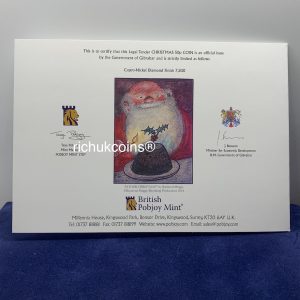Published on
Last Updated on:
I have talked a little bit on the topic of die mark AC in the past, catching it up you can click on Die Marks AC under All Categories on your right panel. Today, let we talk about single die mark, and the start of all die mark variants.
It all begun on sovereigns gold coins in 1973. In the year 1973, the Pobjoy mint were commissioned to mint sovereigns from half to five sovereigns on behalf of the government of Isle of Man. Also, it was the time to see the birth of die mark (single) A/B/C/D/E from a private mint in the post-decimal era in the UK. A special die mark X was created in 1973 and die mark F in 1979. In the meantime, the letters of PM were well-established as the Pobjoy Mint’s mintmark.
According to MacKay (1978, p.51), a single letter like A/B/C/D/E was stamped on IOM sovereigns from half to Five in 1973, and each letter indicated the numbers of coins struck from each die. However, the author has not put more information about the difference among dies, or gave explanation on reasons behind using different dies. Most importantly, this book was published by the Pobjoy Mint.
In terms of a single letter,
Precious metal, (–0)*, single die mark like: A, B, C, D & E, X (only 1973 gold metal, MacKay (1978, p.52)) and F (1979 silver metal);
Man-made metal, (–1)*, 2-digit die mark like AA/AB/AC/AD and BB/BC on 1978 £1 Virenium coin;
Base metal, (–2)*, 2-digit die mark like: AA/AB/AC/AD/AE(?)/AF(?) under the Prefix A, and BB/BC/BD/BE/BF and BA (1988 50p Xmas coin) under the Prefix B** on 1979 50p CN coin.
The difference among above like 2^0(=1) and 2^1(=2, two different finish standards) and 2^2 (=4, Tynwald Hill, a 4-tiered hill). The base 2 comes from a coin having two sides.
The meaning of 2-digit die mark represents the First Day of Minting (FDM) like AA and BB in base metal, B in precious metal.
*Note: considers as position in line.
**Note: AE, AF, BE and BF were only appeared on circulating commemorative coins like IOM Xmas 50p coin, and not on circulating coins. DD was spotted on 1980 circulating coins. Also, the Prefix B indicates a (at least) prooflike or proof finish standard. This source comes from 50p coins.
Having said above, it is easy to direct how to collect IOM Xmas 50p coin and IOM T.T. 50p coin in terms of die mark. In general, coins in loose condition, die marks AA and BB both from circulating commemorative coins are the most common ones but AA with BU striking techniques and BB with Diamond Finish striking techniques. Years like 1980 1981 1982 1983 1984 until 1985 it is hard to decide which direction you are going to, because there is 4 (at least) variants from the Prefix A and the Prefix B and later after post-1997, down to AA/BB (or ND).
Some special IOM/T.T. 50p ones without provenance at the moment, like:
- 1980 IOM Xmas,
- 1981 IOM Xmas XX,
- 1983 IOM T.T. AC,
- 1988 IOM Xmas BA,
- In 1994 IOM Xmas ND,
- 2005 IOM Xmas AA,
- 2011 IOM Xmas AA,
it has BB/BC/BD/BE/BF & BF mule plus two different versions under die letters BB–BB w/ mirror-liked field and BB w/o mirror-liked field, and AA/AB/AC/AD/AE(?)/AF(?). Mistakes noted! Very new product from the perspective of the Mint alongside circulating coins. Official announcement of BC as diamond finish in Krause book (KM#).
this one is possibly linked to 1973 sovereign with die mark X. It has BB and BC under the Prefix B this year. In the same year, IOM T.T. was minted. Mistake noted! New product from the perspective of the Mint alongside circulating coins.
it has AA/AB/AC/AD and BB.
this one indicates that BA coin finish standard is between AA and BB. The BB die marks indicate proof finish, and the AA die marks stand for standard finish. Somehow it echoes 1980 BB w/o mirror-liked field in terms of striking quality.
Striking techniques are totally different.
is shiny like a glass cup.
and ND are only two grades in Xmas series. BB die marks has dropped out since 2004 onwards.
Let us talk about the AC and AD die marks once again here. It has been talking many times in the past, but here it definitively gives you the best picture you can see. Also, you can find them from Die Marks AC/ AD under Categories on your right panel. The AD die mark was established alongside with the AC die mark in 1978 for the purpose of celebrating the first £1 pound coin in British decimal coinage history. The standard finish (i.e., UNC finish) was used on £1 IOM virenium coin from sequence of A to D under the Prefix A. In the year 1979, it only had the AA/AB/AC die marks on £1 virenium coin. However, the AD die mark was spotted on 1979 IOM 50p coin. Most surprisingly, this year 50p coin finish on the AA/AB/AC/AD die marks was significant different, and each die mark had two variants (note, another 1979 AC from 1980 AC). Probably, all steps above were included in the “1972 workable proposal” submitted in 1972 by Mr. D. Pobjoy.
Have you noticed that the AD die mark was shifted from £1 down to 50p? This obviously echoes the Millennium AD event and the Royal visit event in 1979.
It was a amazing story told by the different die marks, but sadly, it had no any official record of them to trace or search. Probably, it is the best disadvantage of collecting IOM post-decimal coin.
Reference
MacKay, J.A., 1978. The Pobjoy Mint Encyclopaedia of Isle of Man Coins and Tokens. 2nd ed. Dumfries, England: The Pobjoy Mint.
#The End







